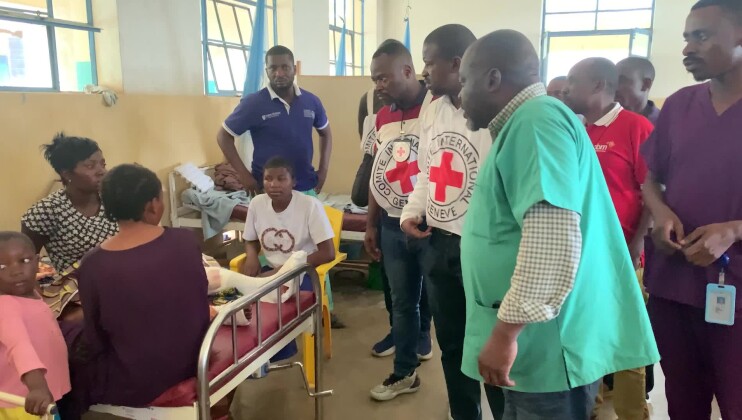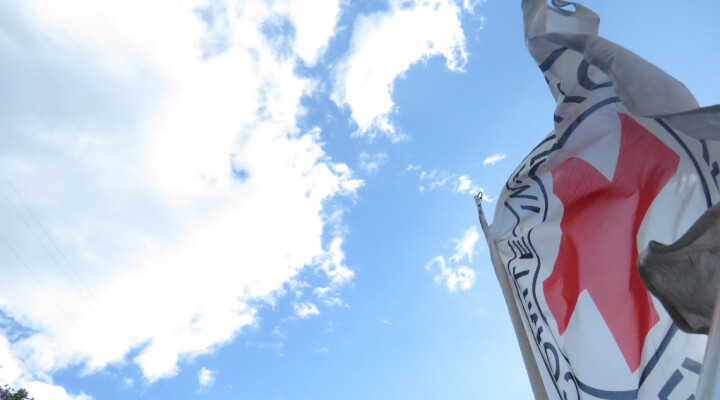Ethiopia: Schools, factories, courthouses: Desperate shelters for the displaced
Schools. Factories. Courthouses. These are just a few of the buildings that now act as shelters for displaced families in southern Ethiopia after a wave of inter-communal clashes along the border areas of Gedeo and West Guji zones drove nearly one million people from their homes.
“We came here because we were attacked,” said Tigist, who fled her home in Hanchabie village. “We left our village empty-handed to save our lives. We travelled and spent three days in the bush to get here.”
People often lack food and clean water and are sleeping on the floor with no blankets or mats. Kochere district in Gedeo zone has seen its population nearly double from 130,000 people to more than 230,000.
“We have seen an awful lot of people…having to move in the face of violence in a very short space of time,” said James Reynolds, ICRC’s Head of Delegation in Ethiopia. “They have moved to public buildings—schools, training centres as well as being hosted by families in the areas to which they’ve moved—so obviously, when something like that happens, the conditions in which those people are living are really very, very difficult.”
The influx of displaced people has also put a heavy strain on host communities, many of whom were already struggling with food insecurity. Hospitals and clinics have also been overwhelmed by the sharp increase in patients.
“We have seen health centres in the area faced with an enormous problem,” said Reynolds. “They were working ok, but suddenly, they’ve got more than double the population coming in and many, many of those people who are coming in are sick already.”
The dismal living conditions faced by many of the displaced put them at-risk of malnutrition and potentially deadly diseases.
“My husband got sick here and I could not help him,” said Tigist. “Since I left empty-handed, it was not possible for me to take him to the hospital for treatment…I intended to go out and beg, but I felt shy…[H]is health deteriorated further, and finally he died.”
The International Committee of the Red Cross (ICRC), together with the Ethiopia Red Cross Society, is working to improve basic living conditions and protect the health of the displaced in Kochere district, Gedeo zone by distributing blankets, sleeping mats and other household items, improving access to safe drinking water, and providing health centres with medicines and medical supplies.
“We have been providing them with additional basic medicines to enable them to treat as well as they can those who are sick,” said Reynolds. “We have done some upgrades on the water supply in the main areas where you’ve got concentration of IDPs, of displaced persons, just to enable a supply of clean water to be accessible to people. And for about—the majority those have been delivered—12,000 people, about 70 or 80,000 people all together, we’ve been giving out shelter kits.”
While aid has increased in recent weeks, it is still insufficient to meet the needs of the displaced. With schools being used as shelters and so many children still displaced, it could also be difficult for students to return to school when the new academic year starts in September. At the same time, some people do not feel safe to return home, while others lost their homes in the clashes, giving them little go back to.
“I want to go back to my village but I am afraid because I am alone now,” said Tigist. “There are also others who lost their husbands like me. It’s frightening to go back.”
Download this footage from ICRC Video Newsroom
For further information, please contact:
Zewdu Ayalew, ICRC Ethiopia (Amharic, English), +251 91 161 4336
Crystal Wells, ICRC Nairobi (English), +254 716 897 265
Follow the ICRC on facebook.com/icrc and twitter.com/icrc
SHOTLIST
Location: Kochere district, Gedeo zone, Ethiopia
Length: 07:02
Format: HD H264 mov
ICRC ref: AV915N
Date: August 15-16, 2018
Copyright: ICRC access all
Location: Kochere district, Gedeo zone, Ethiopia
00:00-00:08: Internally displaced persons (IDPs) take shelter inside a courthouse
00:09-00:16: IDPs gather outside a courthouse (wide shot)
00:17-00:20: Displaced children line up outside a courthouse
SOUNDBITE, TIGIST, Internally displaced person from Hanchabie village
00:21-00:34: We came here because we were attacked. We left our village empty-handed to save our lives. We travelled and spent three days in the bushes to get here.
00:35-01:05: IDPs shelter inside a courthouse (tight and wide shots)
01:06-01:16: IDPs walk around former factory that is being used as a shelter, with makeshift shelters in the yard (wide shot)
01:17-01:38: IDPs shelter inside former factory
01:39-02:17: Lines of makeshift shelters built by IDPs
02:18-02:24: IDPs shelter inside former factory
02:25-02:31: Factory buildings along the roadside that now shelter IDPs
SOUNDBITE, JAMES REYNOLDS, ICRC Head of Delegation, Ethiopia
02:32-02:57: We have seen an awful lot of people, probably about three-quarters of a million people, having to move in the face of violence in a very short space of time. They have moved to public buildings—schools, training centres as well as being hosted by families in the areas to which they’ve moved—so obviously, when something like that happens, the conditions in which those people are living are really very, very difficult.
SOUNDBITE, TIGIST, Internally displaced person from Hanchabie village
02:58-03:27: My husband got sick here and I could not help him. [03:05] No financial resources to take care of him. Since I left empty-handed, it was not possible for me to take him to the hospital for treatment. My brother-in-law could also not help me since he also left under the same conditions. [03:19] I intended to go out and beg, but I felt shy. [03:22] I felt shy, his health deteriorated further, and finally he died.
03:28-03:41: Tight shot of boy sleeping on the floor of a school that is now sheltering IDPs
03:42-03:52: Displaced children and families gather in the yard of a school under makeshift shelters
03:53-03:56: Tight shot of two boys on the floor of a school that is now sheltering IDPs
03:57-04:07: Tight and wide shots of classroom that is now sheltering IDPs
04:08-04:16: Tight shots of water containers, blankets, and belongings being of IDPs sheltering inside a school
04:17-04:32: Wide shot of exterior of a school that is now sheltering IDPs
04:33-04:37: IDPs inside a classroom that is now a shelter
04:38-04:41: A chalkboard and school-desk surrounded by firewood, sleeping mat, jerry cans, and other household items
04:43-04:45: Tight shot of displaced children
04:46-04:59: Wide shot of a school housing IDPs
05:00-05:21: Displaced children and adults outside a school that is now a shelter
05:22-05:27: IDPs sit under a tree outside a school that is now a shelter
SOUNDBITE, TIGIST, Internally displaced person from Hanchabie village
05:28-05:38: I want to go back to my village but I am afraid because I am alone now. There are also others who lost their husbands like me. It’s frightening to go back.
SOUNDBITE, ABRIHAAMI GOLA DANIBARO, Administrator of Kochere district
05:39-05:44: The problem we are facing now is the reoccurrence of provocations and attacks.
SOUNDBITE, JAMES REYNOLDS, ICRC Head of Delegation, Ethiopia
05:45-06:30: We have seen health centres in the area faced with an enormous problem. They were working ok, but suddenly, they’ve got more than double the population coming in and many, many of those people who are coming in are sick already. We have been providing them with additional basic medicines to enable them to treat as well as they can those who are sick. We have done some upgrades on the water supply in the main areas where you’ve got concentration of IDPs, of displaced persons, just to enable a supply of clean water to be accessible to people. And for about—the majority those have been delivered—12,000 people, about 70 or 80,000 people all together, we’ve been giving out shelter kits.
06:31-06:40: Motor and pedestrian traffic along a road in Kochere district
06:41-06:44: Tight shot of a goat on the side of a road in Kochere district
06:44-07:02: ICRC LandCruiser drives down a dirt road lined with buildings where IDPs are sheltering



